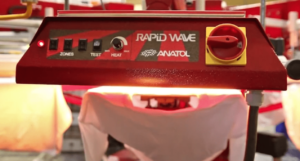Корзина пуста.
ru


Революция в индустрии трафаретной печати благодаря передовым технологиям и качественному обслуживанию
Телефон: +1 847-367-9760
Anatol Equipment Manufacturing Co.
1429 S Shields Dr
Waukegan, IL 60085


Революция в индустрии трафаретной печати благодаря передовым технологиям и качественному обслуживанию
Anatol Equipment Manufacturing Co.
1429 S Shields Dr
Waukegan, IL 60085

You don’t need to lose sleep over your screen printing orders. By following some careful screen printing and testing procedures, you can keep your plastisol inks from washing out of garments.
More often than not, if ink washes out of a garment, the ink wasn’t fully cured to begin with. There are some telltale signs that an improper cure was to blame for the washout: The print will look splotchy and uneven, the ink will crack or the print will peel away from the garment.
To properly cure your ink, you must make sure that the internal temperature of the ink reaches the manufacturer’s recommended curing temperature, which will be between 280 to 320 degrees Fahrenheit. You can use infrared thermometers, donut probes or thermometer tape to check the temperature of your garments as they come off the conveyor dryer, but bear in mind that these thermometers will measure only the surface temperature of the ink, and you need to be sure that the entire application of ink has reached the curing temperature.
When curing, it’s also important to keep in mind that several variables can affect curing times. Cotton fibers hold moisture, so inks printed on a cotton substrate will take longer to cure than inks printed on synthetic fabrics. Thicker fabrics also will take longer to heat up and allow ink to cure. On the flip side, dark-colored substrates will dry in the heat of your dryer, helping the ink to cure faster. The temperature within your shop also can affect the temperature within your dryer.
If your prints appear to be washing away, fibrillation could be to blame. While under-cured ink will look splotchy or cracked, fibrillation will cause prints to look faded. With fibrillation, it’s not the ink that’s to blame, but the garment material below. When the garment is washed, the fibers break loose beneath the ink. The color of the loose fibers will show through the ink, causing the faded look. The print also will take on a “fuzzy” look due to the broken fibers. Softer garments are more prone to fibrillation, and fibrillation is more evident when dark inks are printed on light garments.
To prevent fibrillation, you must adequately coat the shirt with ink so that fibers will not come lose and cause a fuzzy, faded appearance. The challenge comes in using enough ink to prevent fibrillation while still maintaining a quality print with a soft hand feel. That begins with quality ink. The right ink will have a creamy texture that allows it to be pulled in a long strand that doesn’t break, doesn’t build up on screens and provides a flat, even print each and every time.

If you are working with a fibrillation-prone material or if you are having problems preventing fibrillation while avoiding a heavy ink deposit, you can maintain a soft hand feel by printing three thin layers of ink and flash curing in between each layer. You also can use a clear ink primer or an ink catalyst that’s made to combat fibrillation as a base layer. A layer of clear ink over the entire print can keep bright colors bright and prevent fibrillation, but it can give the print a glossy look.
To avoid being surprised by an angry customer whose prints washed away, always test your prints. The best test is always through washing and drying garments several times, just like a customer would. Reserve one print as a “control,” and put the garments through several wash and dry cycles. Make sure you wash a load of clothes rather than individual items because that’s how the garments you deliver to customers will be washed.
Once you’ve thoroughly tested the inks and garments you regularly use, be consistent in your printing. If you consistently use the same ink, the same mesh count, the same squeegee and the same printing angles on familiar substrates and then cure your prints at the same temperature for the same amount of time, you shouldn’t have to worry about the final products you’re sending out the door. If you do change up any aspect of your printing regimen, make sure you do a thorough test run and washing before you complete and ship your order.
If you’re having trouble curing your prints for long-lasting results, make sure you’ve got equipment that’s designed to cure evenly, quickly and efficiently while giving you maximum control over time and temperature settings. And with Anatol’s conveyor dryers and flash cures, you can do just that. Let’s talk about solving your curing issues!
Your message was successfully sent!